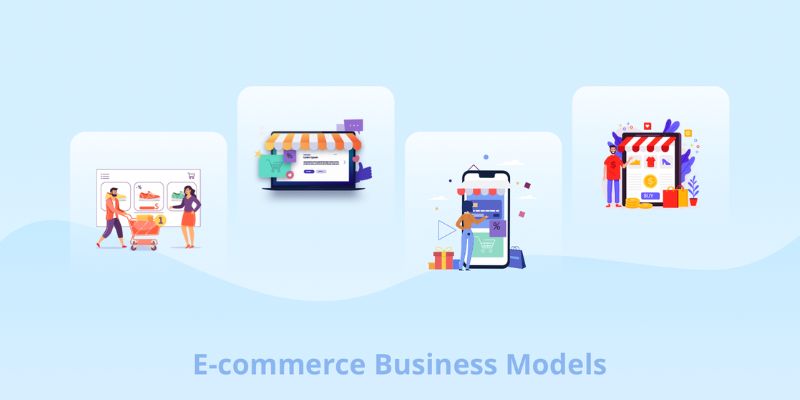E-commerce business model: you hear it tossed around a lot, but what’s the secret sauce to making it a gold mine? What turns browsers into buyers and clicks into cash? I’m here to give you the insider scoop. From pixels on the screen to profits in the bank, we’re ripping the lid off the tactics that keep the online cash registers ringing. Dive deep with me into the models that define the e-commerce world. We’ll look at how online stores make money, how they set up shop for success, and most importantly, how they keep you coming back for more. Buckle up! We’re about to turn digital window shopping into a cash parade.
Understanding E-Commerce Revenue Models
Exploring Online Retail Revenue Streams
We see shops go online everywhere today. They do this to reach more people like you and me. They also find new ways to make money, or what we call “revenue streams”. These are like different pipes that bring water to a tank. Here, each pipe brings money from different places.
The main kinds are direct sales, where stores sell goods right to folks; subscriptions, where we pay each month for goods or services; and ads, where shops make money by showing ads. Online stores might use one or many of these to earn cash.
For example, when you sign up for a game and pay every month to play, that’s a subscription. Like when your mom or dad pays monthly for your favorite video streaming. That’s a steady flow of money for the business.
Monetization Tactics for E-retail
Now, let’s talk ways e-shops turn visits into cash. Think about when you play a mobile game for free. After a while, they offer cool extras if you pay. That’s called ‘freemium’. It’s free at first, but with money, you get more.
Another smart play is dropshipping. Here, the store sells you stuff but doesn’t keep goods in a big room or warehouse. They order from someone else when you buy. It saves them space and money, but you still get what you wanted.
Then there’s affiliate marketing. That’s when someone tells folks about a product online and gets some money if those folks buy it. Like when your favorite online gamer talks about a snack, and you want to try it too.
Also, businesses sell to other businesses, like when a toy maker sells loads of toys to a shop. That’s B2B, and it’s a big part of online business. They also sell to you and me, and that’s B2C. Buying old games from other gamers in an online market? That’s C2C.
Businesses have to think about how to get folks to visit their store too. They work hard to show up first when you search for toys or clothes on the web. This is part of SEO, or making sure people find them online.
There are tricks to sell more and keep shops running smooth. They keep track of what’s in stock, make sure the website is fun and easy to use, and keep prices right. It’s like a big engine that has to keep all parts working good so the whole thing can run.
Everything we talked about – ways to sell, ways to make money, and keeping the shop going – they all are part of what we call the e-commerce business model. And if they do it right, they make a good profit out of every visit we make to their online store. That’s the end goal, making profits from pixels.

Setting Up for E-Commerce Success
The Essentials of E-Commerce Storefront Design
Think of your online store as the face of your brand. It must look good. First off, clear photos and simple menus are a must. Not only do they make your site look pro, but they help folks find what they need fast. Remember, each click is a step closer to a sale! Your site’s color, font, and layout are key too. They have to match your vibe and invite customers in.
What’s more, mobile-friendly design is non-negotiable. With phones in every hand, your store has to be easy to use on small screens. Also, don’t forget to put your best deals and hottest items front and center. This way, you grab attention and may get more sales.
Think about the platform you’ll use. Will you build from scratch, or use a ready-made one? Both have their pros and cons. Custom sites give you freedom but can cost more and take time. Ready-made ones are quick and often cheaper, but may limit your style.
When you set up your store, test everything. Click every link and buy your own product. You want no hiccups for your customers.
Implementing E-Payment Systems and Shopping Cart Technology
Now, let’s talk cash. You have to make it super easy for people to pay you. Safe and simple e-payment systems are the way to go. Customers have their own favorite ways to pay. Offer them options – credit cards, e-wallets, bank transfers. The more you offer the better. You can look at popular payment systems like PayPal or Stripe.
Next up is the shopping cart. It’s the last stop before someone buys, so it has to work right. Make sure customers can see their items, change quantities, or remove stuff easily. Surprise costs? Big no-no. Be upfront with fees or shipping costs to prevent cart abandonment.
For carts, pick tech that’s safe and loads fast. Slow carts can drive folks away. Security logos and clear steps can help people feel safe to go through with their buys.
In a nutshell, your e-commerce store design and payment ops are huge. They can make shopping a breeze, and keep folks coming back. Take time to get these right, and you’re laying down strong ground for your online success.

Strategies for Customer Engagement and Retention
Optimizing the E-Commerce User Experience
Online shops must feel like a fun place to visit. Think about a store where you love to shop. You come back because it feels good, right? Same goes for online stores. The key here is making your site easy and fun to use.
So how do you make your shop user-friendly? First, know that a messy site will scare off your visitors. Keep things clean and simple. Use bright colors, big pictures, and clear buttons. Just like in a real shop, help folks find what they need fast.
Second, loading times are super important. If your pages load slow, folks just leave. Make sure your site is as quick as lightning. This makes shopping smooth and keeps buyers happy.
And always be clear about how to buy. If customers get confused, they won’t buy a thing. Help them understand each step, from picking items to check out.
Now, let’s chat about mobile phones. Lots of us shop on our phones now. So, your site must work great on mobile too. Big buttons and text help a lot. And again, it must load fast!
Remember, when folks have fun shopping on your site, they keep coming back. Keep things easy, clear, and quick, and they’ll love your store.
Balancing Acquisition and Retention in Digital Sales
Getting new buyers is great. But keeping them is even better. Getting new customers costs more than keeping the ones you have. So, you want both new folks coming in and old friends returning.
Here’s the deal: first, treat your loyal customers like gold. Offer them cool deals and first looks at new stuff. They’ll feel special and stick around.
Next, be there for your buyers. Great service keeps people happy. When buyers know you’re there to help, they trust you more. And trust means they’ll buy more and stay loyal.
Also, look at what folks buy and suggest other things they might like. This makes shopping more fun for them. And it means more sales for you.
To get new customers, show off your store on social media. Use ads that speak their language and show them you’ve got what they want. Make it easy for them to find and love your store.
And don’t forget emails. Send out news and deals to grab their attention. But keep it fun, not spammy. You want them to look forward to your emails.
Lastly, make sure folks can talk about your store online. Let them share their buys and good times. This way, they help spread the word about your awesome shop.
So there you go, mix it up. Keep your old pals happy and make new friends along the way. Your online shop will grow, and so will your sales. Keep things personal, helpful, and fun, and customers will stay close.

Maximizing Visibility with E-Commerce SEO Techniques
Leveraging Content Optimization for E-Commerce Website Traffic Growth
When we talk about boosting traffic, we eye e-commerce SEO as our top player. Imagine you have a shop in a vast mall. Now, if your shop sits hidden in a corner, sales will likely suffer. That’s where SEO sprints in, guiding customers right to your door—or in this case, your homepage. Using the right words, like “best running shoes,” can make your site shine in web searches. Think of SEO keywords as your store sign, making sure folks know what you sell.
You might wonder, what types of e-commerce platforms work best with SEO? From giant marketplaces to neat boutique stores online, all can climb up search results with proper SEO. It doesn’t matter if you sell to businesses or directly to consumers; SEO is the pulse of your online presence. Good SEO tells search engines, “Here’s what I offer,” making sure your target audience finds you.
And how’s SEO done? First, we pick words that shoppers use to find products like yours. Then we add these gems to your website’s titles, headers, and product descriptions. No need for guesswork; tools show us the hot words that real people search.
“Is content optimization tough?” Not really. Just keep your words clear, friendly, and focused on what buyers might ask for. Your content should help shoppers just like roadside signs help drivers. If you’re selling craft kits, words like “DIY craft kits for kids” can lead curious crafters straight to you.
Analyzing E-Commerce Analytics and Metrics for SEO Insights
Now, how do we know if our SEO strategy works? We’ll need to dive into e-commerce analytics and metrics. These are the scorecards that show if your SEO game is winning. Look at clicks, how long folks stay on your site, and what they click next.
Ask: “What’s my top-selling item?” Let’s say it’s handmade candles. Then you’d ask, “Which of my candle pages pulls in most visits?” Find that golden page and you’ll see the SEO moves making it shine. This tells you what to do for your other pages.
SEO isn’t a one-time thing. It’s a race, with search engines changing the rules as they go. It’s vital to stay in the loop with the latest SEO moves. Small tweaks often can keep you ahead in the game.
Remember, each click can lead to a purchase, making your e-commerce thrive. So, dive deep into those metrics. Let numbers guide your SEO choices. This way, you’re not just shooting in the dark; you’re a sharpshooter, hitting targets and growing your online crowd.
To sum it up, using SEO in e-commerce is like giving customers the perfect map to your treasures. Start with great words, keep your content bright and helpful, and always check the compass of analytics. With these tools, your e-commerce site won’t just exist—it’ll beam bright in the online sky.
In this post, we broke down what it takes to make it big in e-commerce. We looked at how money flows in from different parts of online selling and the smart ways to add to your total sales. We dived into setting up your shop just right, from having a neat design to adding a smooth way to pay and drop items in a cart. Then we talked about keeping customers coming back. We shared tips on making shopping on your site a breeze and finding the right mix of new and old shoppers to target.
As a wrap-up, it’s clear that to win in the online market, you need a solid plan. You have to draw people in, make their visit worth it, and get them to buy, not just once, but often. And don’t forget, tuning your content for search engines can really help you stand out. So, take these tips, apply them, and watch your store grow. Thanks for reading – now go sell like a pro!
Q&A :
Sure, considering the keyword “E-commerce business model”, here are some potential FAQs that you could use:
What are the main types of e-commerce business models?
E-commerce business models can be categorized into several types based on the nature of the transaction and the parties involved. The primary models include B2C (Business-to-Consumer), B2B (Business-to-Business), C2C (Consumer-to-Consumer), and C2B (Consumer-to-Business). Each model targets different market segments and requires unique marketing and operation strategies.
How do e-commerce business models generate revenue?
E-commerce businesses can generate revenue through various streams such as direct product sales, subscription services, transaction fees, affiliate marketing, and advertising. The choice of revenue model often depends on the business’s goals, the nature of the products or services offered, and the target audience.
What is the difference between a marketplace and an online store?
The term ‘marketplace’ refers to an e-commerce platform where multiple vendors can offer their products or services to consumers. Examples include Amazon and eBay. An ‘online store’ usually denotes a website where a single business sells its goods directly to customers. Both fall under the e-commerce umbrella but operate with different business structures.
How important is choosing the right e-commerce business model?
The selection of an appropriate e-commerce business model is crucial as it impacts everything from your marketing approach to supply chain logistics and profitability. It should align with your product or service offerings, target market, and long-term business objectives. An unfit model can lead to inefficient operations and inadequate customer engagement.
Can an e-commerce business model adapt to market changes?
Yes, flexibility is one of the key advantages of e-commerce business models. They can often quickly adapt to market changes, consumer behavior shifts, and technological advancements. Many e-commerce businesses continually assess and iteratively refine their models to stay competitive and meet evolving market demands.

